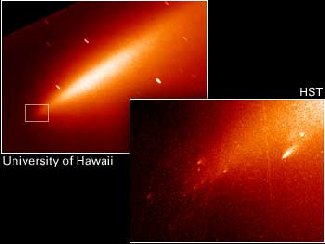The left-most picture here was taken by a ground-based telescope run by the University of Hawaii. In this image, Comet Linear appears as a diffuse, elongated cloud of debris without any visible nucleus. The image on the right was taken by the Hubble Space Telescope on the same day, August 5, 2000. Hubble's resolution was needed to show that the nucleus of the comet had actually fragmented into many pieces. Scientists call these leftover pieces "cometesimals". Hubble has found at least 16 of these "cometesimals", some of which are as wide as 330 feet across.
Click on image for full size
NASA, Harold Weaver (Johns Hopkins University), and the HST Comet LINEAR Investigation Team
Related links:
Comet Section
The Amazing, Vanishing Linear!
News story originally written on May 25, 2001
Comet Linear is a special comet. This comet actually blew apart last summer when it came closest to
the Sun! It got really bright when it blew apart! But now, comet Linear is just a trail of dust and rocky pieces orbiting the Sun.
Astronomers have been studying the leftover pieces of Linear. Some are as small as a piece of dust and some are as big as a football field! But astronomers haven't seen medium-size pieces - it's like they disappeared!
So far there doesn't seem to be enough pieces to make up comet Linear before it broke apart. It's like there are pieces missing to a puzzle. Maybe scientists just need to find more pieces to the puzzle or maybe scientists will change their minds as to how big Linear was.
You might also be interested in:

It was another exciting and frustrating year for the space science program. It seemed that every step forward led to one backwards. Either way, NASA led the way to a great century of discovery. Unfortunately,
...more
The Space Shuttle Discovery lifted off from Kennedy Space Center on October 29th at 2:19 p.m. EST. The sky was clear and the weather was great. This was the America's 123rd manned space mission. A huge
...more
Scientists found a satellite orbiting the asteroid, Eugenia. This is the second one ever! A special telescope allows scientists to look through Earth's atmosphere. The first satellite found was Dactyl.
...more
The United States wants Russia to put the service module in orbit! The module is part of the International Space Station. It was supposed to be in space over 2 years ago. Russia just sent supplies to the
...more
A coronal mass ejection (CME) happened on the Sun last month. The material that was thrown out from this explosion passed the ACE spacecraft. ACE measured some exciting things as the CME material passed
...more
Trees and plants are a very important part of this Earth. Trees and plants are nature's air conditioning because they help keep our Earth cool. On a summer day, walking bare-foot on the sidewalk burns,
...more
There is something special happening in the night sky. Through mid-May, you will be able to see five planets at the same time! This doesn't happen very often, so you won't want to miss this. Use the links
...more















